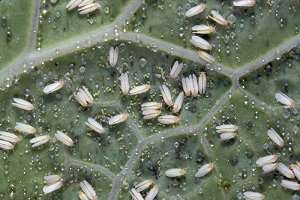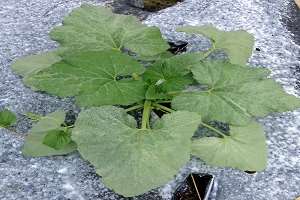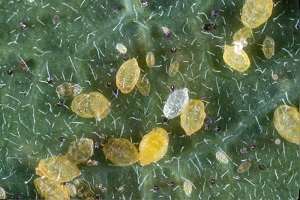By Xavier Martini,

Figure 1. Whitefly adults and eggs (photo credit James Castner)
Outbreaks of sweetpotato whiteflies (also called silverleaf whitefly) Bemisia tabaci (Figure 1 above) have been recorded recently in the Florida Panhandle and South Georgia on tomatoes and other vegetables. Whitefly is a generalist herbivore insect that feeds on 600 host plants. Sweetpotato whitefly damages plants directly by feeding and cause silverleaf disorder in cucurbits (Figure 2), and irregular ripening in tomato. It also vectors over 111 different plant viruses such as the Squash Vein Yellowing Virus that can kill watermelon plants and results in necrotic areas on the fruit, the Cucurbit Leaf Crumple Virus that is mainly destructive for squash, but also affects other cucurbits, and the Tomato Yellow Leaf Curl Virus that affects tomatoes.

Figure 2. Silverleaf disorder on squash
This arrival of whitefly is quite unusual at this time of the year in the Florida Panhandle. Whitefly densities usually increase in October when cotton is defoliated and soybean senesces. This early arrival of whiteflies requires attention given the recent outbreak of Q biotype whiteflies in the Florida landscape. Sweetpotato whitefly is a complex of 28 cryptic species. In the US, the most common are the B and the Q biotypes. The Q biotype is a particular source of concern, as it is more resistant to insecticides than B biotype, and is replacing B biotype in other parts of the world. Since July 2016, Q biotype has been found in 8 counties in Florida, but not in the Panhandle to this point.
Biotype Q and B are indistinguishable visually, and must be discriminated by genetic analysis. The whiteflies collected so far by the NFREC in Gadsden County were all B biotypes, but it is important to pursue the monitoring of our whitefly population to be sure that the Q biotype does not settle in our area.
To sample for biotyping, sample one whitefly per plant, and collect between 10 to 50 whiteflies. Keep whiteflies collected on different host plants separate. Adults can be collected by hand or nymphs, and pupae (Figure 3) can be detached from leaves with a small knife. Store in 95% ethanol or freeze and immediately bring them to the NFREC, or to your local extension agent who can send them to a lab for biotyping. Alternatively, infested foliage can be brought directly to NFREC for processing.

Figure 3. Whitefly nymphs and pupae (photo credit Lyle Buss)
Simple cultural practices can help reduce whitefly damage. Sanitation is one of them. After harvest, crop residue such as tomato plants should be removed to reduce virus reservoirs in the crop. Natural enemies are an important part of whitefly control. It has been found that whitefly outbreaks occurred more often when natural enemy populations are absent, because of repeated insecticidal sprays. Natural enemies of sweetpotato whitefly include parasitoids, lacewing, minute pirate bug and some minute species of ladybird beetles. It is always important to assess the presence of natural enemies before applying an insecticidal treatment.
If whiteflies are present in high density, and natural enemies are not found, insecticide application is advised. Based on experience, these populations will likely need to be managed until early November. It has to be noted, that sweetpotato whitefly is particularly challenging to control with insecticides because they live on the underside of the leaf, and easily develop resistance against insecticides. To optimize insecticidal efficiency against sweetpotato whitefly it is preferable to use systemic insecticides such as neonicotinoid (imidacloprid, thiamethoxam, dinotefuran) and diamides (cyazypyr). Additionally, Pymetrozine (Fulfill) has been found to reduce virus transmission in tomatoes. Foliar application of neonicotinoid should be restricted to the period before flowering because of toxicity to bees. For organic producers, neem oil or insecticidal soap are potential alternatives to synthetic insecticides. Because whitefly is prone to development of resistance, it is crucial to rotate insecticide modes action (which can be found in the Vegetable Production Handbook and on pesticide labels).
Source: ufl.edu